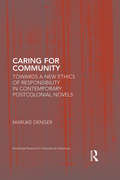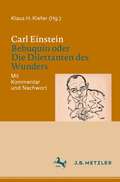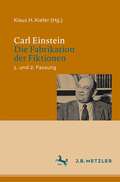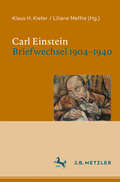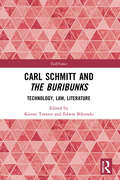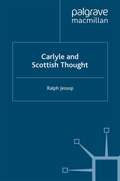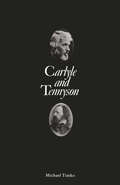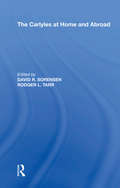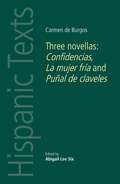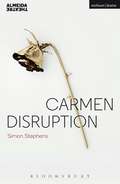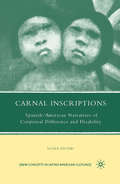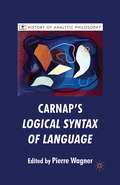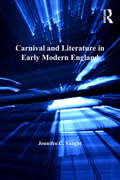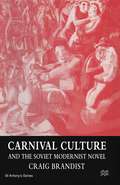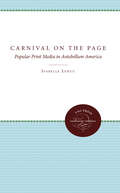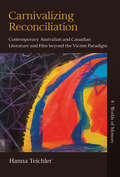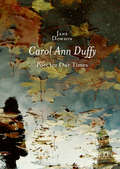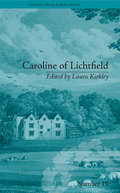- Table View
- List View
Caring for Community: Towards a New Ethics of Responsibility in Contemporary Postcolonial Novels (Routledge Research in Postcolonial Literatures)
by Marijke DengerCaring for Community: Towards a New Ethics of Responsibility in Contemporary Postcolonial Novels focuses on four highly acclaimed publications in order to argue for a new understanding of community and its ethical framework in recent literary texts. Traditionally, community has been understood to function on the basis of individuals’ readiness to establish relationships of reciprocal responsibility. This book, however, argues that community and non-reciprocity need not be mutually exclusive categories. Examining works by leading contemporary postcolonial authors and reading them against Judith Butler’s post-9/11 concept of global political community, the book explores how concrete acts of responsibility can be carried out in recognition of various others, even and precisely when those others cannot be expected to respond. The literary analyses draw on a rich theoretical framework that includes approaches to care, hospitality and the ethical encounter between self and other. Overall, this book establishes that the novels’ protagonists, by investing in an ethics of responsibility that does not require reciprocity, acquire the agency to envisage new forms of community. By reflecting on the nature and effect of this agency and its representation in contemporary literary texts, the book also considers the role of postcolonial studies in addressing highly topical questions regarding our co-existence with others.
Carl Einstein: Mit Kommentar und Nachwort
Durch sein Sterbenswörtchen „Aus“ bringt Bebuquin ein Buch zur Welt, das seinen Namen trägt: „Bebuquin oder Die Dilettanten des Wunders“. Wie der Titel schon konzediert: um ein regelrechtes „Wunder“ handelt es sich nicht, aber der Verfasser, Carl Einstein (1885–1940), überwindet die judäo-christliche Dekadenz durch den Mythos einer „absoluten“ Kunst. Der knapp zwanzigjährige Autor findet dazu „geistige“ Nahrung an der Berliner Universität wie auch in Berliner Künstlerkneipen. Die „intermediale“ Edition folgt der ersten Buchausgabe von 1912, unterzieht den Text einem „close reading“ und versucht in 32 Abbildungen die Welt in Bebuquins Kopf zu veranschaulichen. Carl Einsteins Werk wies der gesamten Avantgarde „die Richtung“ (so Hugo Ball), Expressionismus, DADA, Kubismus, Surrealismus, bis der Autor angesichts der politischen Lage 1933 den „mythischen“ Avantgardismus, den er in epochemachenden Schriften wie der „Negerplastik“ oder der „Kunst des 20. Jahrhunderts“ selbst propagiert hatte, widerruft und mit der „Fabrikation der Fiktionen“ für unzeitgemäß erklärt. Einstein engagiert sich auf Seiten der spanischen Anarchisten gegen Franco und Hitler. Er sucht 1940 den Freitod.
Carl Einstein: 1. und 2. Fassung
Die neue Edition von Carl Einsteins unveröffentlichtem Werk Die Fabrikation der Fiktionen bringt die beiden erhaltenen Fassungen und eröffnet mit Nachwort und ausführlichem Register eine neue, kritische Sicht auf die klassisch gewordene Moderne. In der Wirtschaftskrise der 30er Jahre verschärft Einstein (1885‒1940) die Kunst- und Gesellschaftskritik, die seine Schriften schon immer geprägt hatte, erneut. Seine Werke wie Bebuquin (1906‒1912), Negerplastik (1915), Die Kunst des 20. Jahrhunderts (1926, 1928, 1931) hatten Epoche gemacht. Nun aber widerruft er in der Fabrikation der Fiktionen das eigene Schaffen, ja, er attackiert, ohne Namen zu nennen, vor kurzem noch bewunderte Künstler, wie Picasso, auch befreundete Kollegen, wie Gottfried Benn, vor allem aber die Surrealisten um André Breton. Er entlarvt die Analogie von Imagination und Spekulation in Poesie und Kapitalismus. Die Moderne erscheint ihm als missratene Primitive. Die Fabrikation der Fiktionen bietet nicht nur Kritik und Satire, sie enthält auch markante Insider-Kommentare zur Avantgarde in Kunst und Literatur. Angesichts der Machtergreifung Hitlers ruft Einstein Arbeiter und Intellektuelle zum revolutionären Handeln auf. Sein tragisches Lebensende verhindert die Veröffentlichung.
Carl Einstein. Briefwechsel 1904–1940
Carl Einstein (1885‒1940) war einer der bedeutendsten Schriftsteller, Kunstkritiker und Theoretiker der Avantgarde des 20. Jahrhunderts. Er war auch ein Mann der Tat, kämpfte in Berlin auf Seiten von Spartakus und in der Kolonne Durruti in Spanien gegen Reaktion und Faschismus. In seiner Korrespondenz spiegeln sich alle Strömungen und Konflikte, die Literatur, Kunst und Politik Europas bewegten. Er wechselte Briefe mit bekannten Größen der Kunstgeschichte wie etwa Picasso und Paul Klee. Daniel-Henry Kahnweiler, der Pariser Kunsthändler, wurde sein Freund. Für seine legendäre Zeitschrift „Documents“ korrespondierte er mit Gelehrten aus aller Welt. In Einsteins Briefen erfährt man auch von vielen Projekten, die er nicht vollenden konnte. Von seiner weitaus bedeutenderen Korrespondenz haben sich 425 Texte, einschließlich offener Briefe oder auch briefartiger Widmungen, erhalten. Sie werden chronologisch geordnet, detailliert kommentiert und mittels eines Personen-, Werk- und Zeitschriftenregisters erschlossen. Französische Briefe werden übersetzt. Carl Einsteins Briefwechsel stellt für literatur- und kunst-, aber auch für sozialgeschichtliche Forschungen zum 20. Jahrhundert reichhaltiges Material zur Verfügung.
Carl Schmitt and The Buribunks: Technology, Law, Literature (TechNomos)
by Edwin Bikundo Kieran TranterIn 1918 a young Carl Schmitt published a short satirical fiction entitled The Buribunks. He imagined a future society of beings who consistently wrote and disseminated their personal diaries. Schmitt would go on to become the infamous philosopher of the exception and for a while the ‘Crown Jurist of the Third Reich’. The Buribunks – ironically for beings that lived only for self-memorialisation – has been mostly lost to history. However, the digital realm, with its emphasis on the informatic traces generated by human doing, and the continual interest in Schmitt’s work to explain and criticise contemporary constellations of power, suggests that The Buribunks is a text whose epoch has come. This volume includes the first full translation into English of The Buribunks and a selection of critical essays on the text, its meanings in the digital present, its playing with and criticism of the literary form, and its place within Schmitt’s life and work. The Buribunks and the essays provide a complex, critical and provocative invitation to reimagine the relations between the human and their imprint and legacy within archives and repositories. There is a fundamental exploration of what it means to be a being intensely aware of ‘writing itself’. This is not just a volume for critical lawyers, literary scholars and the Schmitt literati. It is a volume that challenges a broad range of disciplines, from philosophy to critical data studies, to reflect on the digital present and its assembled and curated beings. It is a volume that provides a set of fantastically located concepts, images and histories that traverse ideas and practices, play and politics, power and possibility.
Carl Schmitt and The Buribunks: Technology, Law, Literature (TechNomos)
by Kieran TranterIn 1918 a young Carl Schmitt published a short satirical fiction entitled The Buribunks. He imagined a future society of beings who consistently wrote and disseminated their personal diaries. Schmitt would go on to become the infamous philosopher of the exception and for a while the ‘Crown Jurist of the Third Reich’. The Buribunks – ironically for beings that lived only for self-memorialisation – has been mostly lost to history. However, the digital realm, with its emphasis on the informatic traces generated by human doing, and the continual interest in Schmitt’s work to explain and criticise contemporary constellations of power, suggests that The Buribunks is a text whose epoch has come. This volume includes the first full translation into English of The Buribunks and a selection of critical essays on the text, its meanings in the digital present, its playing with and criticism of the literary form, and its place within Schmitt’s life and work. The Buribunks and the essays provide a complex, critical and provocative invitation to reimagine the relations between the human and their imprint and legacy within archives and repositories. There is a fundamental exploration of what it means to be a being intensely aware of ‘writing itself’. This is not just a volume for critical lawyers, literary scholars and the Schmitt literati. It is a volume that challenges a broad range of disciplines, from philosophy to critical data studies, to reflect on the digital present and its assembled and curated beings. It is a volume that provides a set of fantastically located concepts, images and histories that traverse ideas and practices, play and politics, power and possibility.
Carlyle and Scottish Thought
by R. JessopThis book initiates a new interdisciplinary approach in the literary and philosophical treatment of Carlyle, challenging the long-held notion that his work was solely influenced by German idealism. Tracing Carlyle's intellectual inheritance through Hume, Reid, and Hamilton, Jessop argues that Carlyle was crucially influenced by Scottish philosophy and that this philosophical discourse can in turn be used to inform critical readings of his texts. The book will be of interest to readers of Carlyle, philosophers, and specialists in the literature and intellectual history of the eighteenth and nineteenth centuries.
Carlyle and Tennyson
by Michael TimkoThis study of Caryle and Tennyson explores their mutual influence and the effect of each on his own time. The author analyzes the specific Carlylean ideas (social, political, religious, aesthetic) and examines the ways in which Tennyson resisted and transformed these ideas and their impact.
The Carlyles at Home and Abroad
by Rodger L. TarrThe Carlyles at Home and Abroad explores the extensive influence of Thomas Carlyle and Jane Welsh Carlyle in England and Scotland, Europe, and the United States. The contributors explore a wide range of topics, such as aesthetics, history, biography, literature, travel writing, feminism and race. The result is a volume that offers a fresh assessment of the couple as national and international figures.
The Carlyles at Home and Abroad
by Rodger L. TarrThe Carlyles at Home and Abroad explores the extensive influence of Thomas Carlyle and Jane Welsh Carlyle in England and Scotland, Europe, and the United States. The contributors explore a wide range of topics, such as aesthetics, history, biography, literature, travel writing, feminism and race. The result is a volume that offers a fresh assessment of the couple as national and international figures.
Carmen de Burgos: Three novellas: <i>Confidencias</i>, <i>La mujer fría</i> and <i>Puñal de claveles</i>
by Abigail Lee SixCarmen de Burgos (1867-1932), an influential journalist, socio-political activist, and a key literary figure in the cultural ferment of pre-war Madrid, is currently being rediscovered, having languished in a long and regrettable oblivion during the Franco years. This scholarly edition of three stories by de Burgos includes the unabridged texts, vocabulary, notes, chronology, bibliography, 'temas de debate y discusión', and a critical introduction. Confidencias is the fictional diary of a young woman, describing her first adulterous relationship and exploiting the narratological possibilities of the diary form. La mujer fría is a vampire story featuring perhaps the very first pitiable vampire, or at least one of the earliest examples of this type, whilst ingeniously maintaining undecidability as to whether the protagonist is supernatural. Puñal de claveles narrates a wedding-day elopement. Inspired by the real-life 'Crimen de Níjar', Federico García Lorca drew on both stories for his Bodas de sangre.
Carmen Disruption (Modern Plays)
by Simon StephensI'll gather my breath. I'll walk out of my room. I'll know exactly where I'm going to go. The voice in my head tells me exactly where to go. In the opulent grandeur of a European city, a renowned singer abandons the opera house for the truth of the streets. A gorgeous prostitute. A tough-talking taxi driver. A global trader. A teenage dreamer. Everyone's looking for something.Simon Stephens's strange and beautiful play re-imagines Bizet's opera Carmen and the possibility of love in a fractured urban world. Carmen Disruption received its world premiere at the Deutsche Schauspielhaus, Hamburg, in March 2014 and its UK premiere at the Almeida Theatre on 10 April 2015.
Carmen Disruption: Three Kingdoms; The Trial Of Ubu; Morning; Carmen Disruption (Modern Plays)
by Simon StephensI'll gather my breath. I'll walk out of my room. I'll know exactly where I'm going to go. The voice in my head tells me exactly where to go. In the opulent grandeur of a European city, a renowned singer abandons the opera house for the truth of the streets. A gorgeous prostitute. A tough-talking taxi driver. A global trader. A teenage dreamer. Everyone's looking for something.Simon Stephens's strange and beautiful play re-imagines Bizet's opera Carmen and the possibility of love in a fractured urban world. Carmen Disruption received its world premiere at the Deutsche Schauspielhaus, Hamburg, in March 2014 and its UK premiere at the Almeida Theatre on 10 April 2015.
Carnal Inscriptions: Spanish American Narratives of Corporeal Difference and Disability (New Directions in Latino American Cultures)
by S. AntebiThis book explores manifestations of physical disability in Spanish American narrative fiction and performance, from José Martí's late nineteenth century crónicas, to Mario Bellatín's twenty-first century novels, from the performances of Guillermo Gómez-Peña and Coco Fusco to the testimonio and filmic depictions of Gabriela Brimmer.
Carnap's Logical Syntax of Language (History of Analytic Philosophy)
by P. WagnerThis volume's aim is to provide an introduction to Carnap's book from a historical and philosophical perspective, each chapter focusing on one specific issue. The book will be of interest not only to Carnap scholars but to all those interested in the history of analytical philosophy.
Carnival and Literature in Early Modern England
by Jennifer C. VaughtCarnival and Literature in Early Modern England explores the elite and popular festive materials appropriated by authors during the English Renaissance in a wide range of dramatic and non-dramatic texts. Although historical records of rural, urban, and courtly seasonal customs in early modern England exist only in fragmentary form, Jennifer Vaught traces the sustained impact of festivals and rituals on the plays and poetry of sixteenth- and seventeenth-century English writers. She focuses on the diverse ways in which Shakespeare, Spenser, Marlowe, Dekker, Jonson, Milton and Herrick incorporated the carnivalesque in their works. Further, she demonstrates how these early modern texts were used-and misused-by later writers, performers, and inventors of spectacles, notably Mardi Gras krewes organizing parades in the American Deep South. The works featured here often highlight violent conflicts between individuals of different ranks, ethnicities, and religions, which the author argues reflect the social realities of the time. These Renaissance writers responded to republican, egalitarian notions of liberty for the populace with radical support, ambivalence, or conservative opposition. Ultimately, the vital, folkloric dimension of these plays and poems challenges the notion that canonical works by Shakespeare and his contemporaries belong only to 'high' and not to 'low' culture.
Carnival and Literature in Early Modern England
by Jennifer C. VaughtCarnival and Literature in Early Modern England explores the elite and popular festive materials appropriated by authors during the English Renaissance in a wide range of dramatic and non-dramatic texts. Although historical records of rural, urban, and courtly seasonal customs in early modern England exist only in fragmentary form, Jennifer Vaught traces the sustained impact of festivals and rituals on the plays and poetry of sixteenth- and seventeenth-century English writers. She focuses on the diverse ways in which Shakespeare, Spenser, Marlowe, Dekker, Jonson, Milton and Herrick incorporated the carnivalesque in their works. Further, she demonstrates how these early modern texts were used-and misused-by later writers, performers, and inventors of spectacles, notably Mardi Gras krewes organizing parades in the American Deep South. The works featured here often highlight violent conflicts between individuals of different ranks, ethnicities, and religions, which the author argues reflect the social realities of the time. These Renaissance writers responded to republican, egalitarian notions of liberty for the populace with radical support, ambivalence, or conservative opposition. Ultimately, the vital, folkloric dimension of these plays and poems challenges the notion that canonical works by Shakespeare and his contemporaries belong only to 'high' and not to 'low' culture.
Carnival Culture and the Soviet Modernist Novel (St Antony's Series)
by Craig BrandistThis book examines the work of five Soviet prose writers - Olesha, Platonov, Kharms, Bulgakov and Vaginov - in the light of the carnivalesque elements of Russian popular culture. It shows that while Bakhtin's account of carnival culture sheds considerable light on the work of these writers, they need to be considered with reference to both the concrete forms of Russian and Soviet popular culture and the changing institutional framework of Soviet society in the 1920s and 1930s.
Carnival on the Page: Popular Print Media in Antebellum America
by Isabelle LehuuIn the decades before the Civil War, American society witnessed the emergence of a new form of print culture, as penny papers, mammoth weeklies, giftbooks, fashion magazines, and other ephemeral printed materials brought exuberance and theatricality to public culture and made the practice of reading more controversial. For a short yet pivotal period, argues Isabelle Lehuu, the world of print was turned upside down. Unlike the printed works of the eighteenth century, produced to educate and refine, the new media aimed to entertain a widening yet diversified public of men and women. As they gained popularity among American readers, these new print forms provoked fierce reactions from cultural arbiters who considered them transgressive. No longer the manly art of intellectual pursuit, reading took on new meaning; reading for pleasure became an act with the power to silently disrupt the social order.Neither just an epilogue to an earlier age of scarce books and genteel culture nor merely a prologue to the late nineteenth century and its mass culture and commercial literature, the antebellum era marked a significant passage in the history of books and reading in the United States, Lehuu argues.Originally published 2000.A UNC Press Enduring Edition -- UNC Press Enduring Editions use the latest in digital technology to make available again books from our distinguished backlist that were previously out of print. These editions are published unaltered from the original, and are presented in affordable paperback formats, bringing readers both historical and cultural value.
Carnivalizing Reconciliation: Contemporary Australian and Canadian Literature and Film beyond the Victim Paradigm (Worlds of Memory #8)
by Hanna TeichlerCriminal justice inquiries may be the most historically dramatic means for coming to terms with traumatic legacies, but it is in the more subtle social and cultural processes of “memory work” that most individuals encounter historical reconciliation in practice. This book analyzes, within the realms of national literature and film, recent Australian and Canadian attempts to reconcile with Indigenous populations in the wake of forced child removal. As Hanna Teichler demonstrates, their systematic emphasis on the subjectivity of the victim is “carnivalesque,” temporarily overturning discursive hierarchies. Such fictions of reconciliation venture beyond simplistic narratives and identities defined by victimization, offering new opportunities for confronting painful histories.
Carnivalizing Reconciliation: Contemporary Australian and Canadian Literature and Film beyond the Victim Paradigm (Worlds of Memory #8)
by Hanna TeichlerTransitional justice and national inquiries may be the most established means for coming to terms with traumatic legacies, but it is in the more subtle social and cultural processes of “memory work” that the pitfalls and promises of reconciliation are laid bare. This book analyzes, within the realms of literature and film, recent Australian and Canadian attempts to reconcile with Indigenous populations in the wake of forced child removal. As Hanna Teichler demonstrates, their systematic emphasis on the subjectivity of the victim is problematic, reproducing simplistic narratives and identities defined by victimization. Such fictions of reconciliation venture beyond simplistic narratives and identities defined by victimization, offering new opportunities for confronting painful histories.
Carnivalizing Reconciliation: Contemporary Australian and Canadian Literature and Film beyond the Victim Paradigm (Worlds of Memory #8)
by Hanna TeichlerTransitional justice and national inquiries may be the most established means for coming to terms with traumatic legacies, but it is in the more subtle social and cultural processes of “memory work” that the pitfalls and promises of reconciliation are laid bare. This book analyzes, within the realms of literature and film, recent Australian and Canadian attempts to reconcile with Indigenous populations in the wake of forced child removal. As Hanna Teichler demonstrates, their systematic emphasis on the subjectivity of the victim is problematic, reproducing simplistic narratives and identities defined by victimization. Such fictions of reconciliation venture beyond simplistic narratives and identities defined by victimization, offering new opportunities for confronting painful histories.
Carol Ann Duffy: Poet for Our Times
by Jane DowsonThis is the only monograph to consider the entire thirty-year career, publications, and influence of Britain's first female poet laureate. It outlines her impact on trends in contemporary poetry and establishes what we mean by ‘Duffyesque’ concerns and techniques. Discussions of her writing and activities prove how she has championed the relevance of poetry to all areas of contemporary culture and to the life of every human being. Individual chapters discuss the lyrics of ‘love, loss, and longing’; the socially motivated poems about the 1980s; the female-centred volumes and poems; the relationship between poetry and public life; and poetry and childhood and written for children. The book should whet the appetite of readers who know little of Duffy’s work to find out more, while providing students and scholars with an in-depth analysis of the poems in their contexts. It draws on a wide range of critical works and includes an extensive list of further reading.
Caroline of Lichtfield: by Isabelle de Montolieu (Chawton House Library: Women's Novels #19)
by Laura KirkleyThomas Holcroft’s 1786 translation of Isabelle de Montolieu’s novel is a textual encounter between a rather conventional Swiss woman and a British radical. Just as Montolieu did in her own translations, Holcroft reworked parts of the novel to make it more appealing to his intended audience.
Caroline of Lichtfield: by Isabelle de Montolieu (Chawton House Library: Women's Novels)
by Laura KirkleyThomas Holcroft’s 1786 translation of Isabelle de Montolieu’s novel is a textual encounter between a rather conventional Swiss woman and a British radical. Just as Montolieu did in her own translations, Holcroft reworked parts of the novel to make it more appealing to his intended audience.
